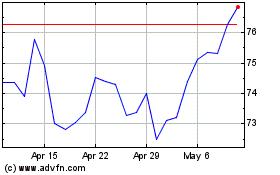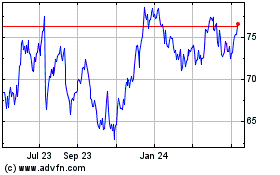State Street Corporation Announces an Authorization to Purchase Up to $2.1 Billion of its Common Stock
March 14 2013 - 5:35PM

One Lincoln Street
Boston, MA 02111
United States of America
State Street
Corporation Announces an Authorization to Purchase Up to $2.1
Billion of its Common Stock
BOSTON March 14, 2013 -- State Street Corporation,
("the Company") (NYSE:STT) today announced that its Board of
Directors has approved a new common stock purchase program
authorizing the purchase of up to $2.1 billion of its common stock
through March 31, 2014, reinforcing the Company's priority to
return capital to its shareholders. This new common stock purchase
program authorization follows the 2013 Comprehensive Capital
Analysis and Review (CCAR) process under which the Federal Reserve
reviewed State Street's 2013 capital plan and did not object to the
Company's requested capital actions. The 2013 authorization
represents an increase from the $1.8 billion 2012 common stock
purchase program previously authorized and executed from April 2012
through February 2013.
State Street may commence purchases of its common
stock under this new authorization at any time. Stock purchases may
be made in various types of transactions, including open-market
purchases or transactions off the market, and may be made under
Rule 10b5-1 trading programs. The timing of stock purchases and
number of shares purchased will depend on several factors,
including market conditions and State Street's capital position,
its financial performance and investment opportunities. The common
stock purchase program does not have specific price targets and may
be suspended at any time.
Previously, on February 21, 2013, State Street
announced a quarterly common stock dividend of $0.26 per share
payable on April 12, 2013 to shareholders of record as of April 1,
2013. This dividend represents an increase of $0.02 per share from
the $0.24 per share of common stock quarterly dividend paid on
January 15, 2013.
Additional
Information
State Street Corporation, like other companies covered by the
provisions of Section 165 of the Dodd-Frank Wall Street Reform and
Consumer Protection Act (Dodd-Frank Act), is required to conduct
stress tests semi-annually and to disclose summary results of those
stress tests under the severely adverse scenario established by the
Board of Governors of the Federal Reserve System. State Street's
disclosure can be found on its website, at
www.statestreet.com/stockholder under "Investor Relations".
Forward-Looking
Statements
This news release contains forward-looking statements as defined by
United States securities laws, including statements relating to our
goals and expectations regarding our capital plans, involving
common stock purchases and dividends, and expectations for
returning capital to shareholders. Forward-looking statements are
often, but not always, identified by such forward-looking
terminology as "intend," "plan," "expect," "look," "believe,"
"anticipate," "estimate," "seek," "may," "will," "trend," "target,"
and "goal," or similar statements or variations of such terms.
These statements are not guarantees of future performance, are
inherently uncertain, are based on current assumptions that are
difficult to predict and involve a number of risks and
uncertainties. Therefore, actual outcomes and results may differ
materially from what is expressed in those statements, and those
statements should not be relied upon as representing our
expectations or beliefs as of any date subsequent to March 14,
2013.
Important factors that may affect future results
and outcomes include, but are not limited to:
-
the financial strength and continuing viability of
the counterparties with which we or our clients do business and to
which we have investment, credit or financial exposure, including,
for example, the direct and indirect effects on counterparties of
the current sovereign-debt risks in Europe and other
regions;
-
financial market disruptions or economic
recession, whether in the U.S., Europe, Asia or other
regions;
-
increases in the volatility of, or declines in the
level of, our net interest revenue, changes in the composition of
the assets recorded in our consolidated statement of condition (and
our ability to measure the fair value of investment securities) and
the possibility that we may change the manner in which we fund
those assets;
-
the liquidity of the U.S. and international
securities markets, particularly the markets for fixed-income
securities and inter-bank credits, and the liquidity requirements
of our clients;
-
the level and volatility of interest rates and the
performance and volatility of securities, credit, currency and
other markets in the U.S. and internationally;
-
the credit quality, credit-agency ratings and fair
values of the securities in our investment securities portfolio, a
deterioration or downgrade of which could lead to
other-than-temporary impairment of the respective securities and
the recognition of an impairment loss in our consolidated statement
of income;
-
our ability to attract deposits and other
low-cost, short-term funding, and our ability to deploy deposits in
a profitable manner consistent with our liquidity requirements and
risk profile;
-
the manner and timing with which the Federal
Reserve and other U.S. and foreign regulators implement the
Dodd-Frank Act, the Basel II and Basel III capital and liquidity
standards, and European legislation with respect to the levels of
regulatory capital we must maintain, our credit exposure to third
parties, margin requirements applicable to derivatives, banking and
financial activities and other regulatory initiatives in the U.S.
and internationally, including regulatory developments that result
in changes to our structure or operating model, increased costs or
other changes to how we provide services;
-
adverse changes in the regulatory capital ratios
that we are required to meet, whether arising under the Dodd-Frank
Act, the Basel II or Basel III capital and liquidity standards or
due to changes in regulatory positions, practices or regulations in
jurisdictions in which we engage in banking activities, including
changes in internal or external data, formulae, models, assumptions
or other advanced systems used in calculating our capital ratios
that cause changes in those ratios as they are measured from period
to period;
-
increasing requirements to obtain the prior
approval of the Federal Reserve or our other regulators for the
use, allocation or distribution of our capital or other specific
capital actions or programs, including acquisitions, dividends and
equity purchases, without which our growth plans, distributions to
shareholders, equity purchase programs or other capital initiatives
may be restricted;
-
changes in law or regulation that may adversely
affect our business activities or those of our clients or our
counterparties, and the products or services that we sell,
including additional or increased taxes or assessments thereon,
capital adequacy requirements, margin requirements and changes that
expose us to risks related to the adequacy of our controls or
compliance programs;
-
our ability to promote a strong culture of risk
management, operating controls, compliance oversight and governance
that meet our expectations or those of our clients and our
regulators;
-
the credit agency ratings of our debt and
depository obligations and investor and client perceptions of our
financial strength;
-
delays or difficulties in the execution of our
previously announced Business Operations and Information Technology
Transformation program, which could lead to changes in our
estimates of the charges, expenses or savings associated with the
planned program and may cause volatility of our earnings;
-
the results of, and costs associated with,
government investigations, litigation, and similar claims,
disputes, or proceedings;
-
the possibility that our clients will incur
substantial losses in investment pools for which we act as agent,
and the possibility of significant reductions in the valuation of
assets underlying those pools;
-
adverse publicity or other reputational
harm;
-
dependencies on information technology,
complexities and costs of protecting the security of our systems
and difficulties with protecting our intellectual property
rights;
-
our ability to grow revenue, control expenses,
attract and retain highly skilled people and raise the capital
necessary to achieve our business goals and comply with regulatory
requirements;
-
potential changes to the competitive environment,
including changes due to regulatory and technological changes, the
effects of industry consolidation, and perceptions of State Street
as a suitable service provider or counterparty;
-
potential changes in how and in what amounts
clients compensate us for our services, and the mix of services
provided by us that clients choose;
-
the ability to complete acquisitions, joint
ventures and divestitures, including the ability to obtain
regulatory approvals, the ability to arrange financing as required
and the ability to satisfy closing conditions;
-
the risks that acquired businesses and joint
ventures will not achieve their anticipated financial and
operational benefits or will not be integrated successfully, or
that the integration will take longer than anticipated, that
expected synergies will not be achieved or unexpected disynergies
will be experienced, that client and deposit retention goals will
not be met, that other regulatory or operational challenges will be
experienced and that disruptions from the transaction will harm our
relationships with our clients, our employees or
regulators;
-
our ability to recognize emerging needs of our
clients and to develop products that are responsive to such trends
and profitable to us; the performance of and demand for the
products and services we offer; and the potential for new products
and services to impose additional costs on us and expose us to
increased operational risk;
-
our ability to anticipate and manage the level and
timing of redemptions and withdrawals from our collateral pools and
other collective investment products;
-
our ability to control operating risks, data
security breach risks, information technology systems risks and
outsourcing risks, and our ability to protect our intellectual
property rights, the possibility of errors in the quantitative
models we use to manage our business and the possibility that our
controls will prove insufficient, fail or be
circumvented;
-
changes in accounting standards and practices;
and
-
changes in tax legislation and in the
interpretation of existing tax laws by U.S. and non-U.S. tax
authorities that affect the amount of taxes due.
Other important factors that could cause actual
results to differ materially from those indicated by any
forward-looking statements are set forth in our 2012 Annual Report
on Form 10-K and our subsequent SEC filings. We encourage investors
to read these filings, particularly the sections on risk factors,
for additional information with respect to any forward-looking
statements and prior to making any investment decision. The
forward-looking statements contained in this news release speak
only as of the date hereof, March 14, 2013, and we do not undertake
efforts to revise those forward-looking statements to reflect
events after that date.
Investor
Relations Contact: Valerie
Haertel
Telephone: +1 617/664-3477
Media Contact:
Hannah Grove
Telephone: +1 617/664-3377
Disclosure of Company-Run Stress
Test Results
This
announcement is distributed by Thomson Reuters on behalf of Thomson
Reuters clients.
The owner of this announcement warrants that:
(i) the releases contained herein are protected by copyright and
other applicable laws; and
(ii) they are solely responsible for the content, accuracy and
originality of the
information contained therein.
Source: State Street Corporation via Thomson Reuters
ONE
HUG#1685491
State Street (NYSE:STT)
Historical Stock Chart
From Jun 2024 to Jul 2024

State Street (NYSE:STT)
Historical Stock Chart
From Jul 2023 to Jul 2024
